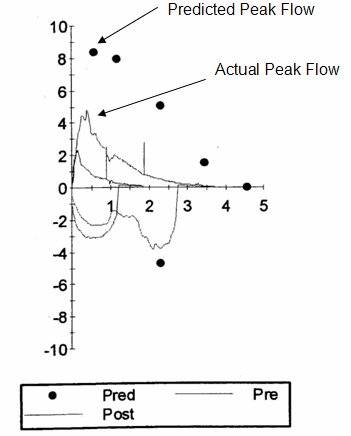
Case 2 Answer
A 54 year-old man presents to his primary care provider with dyspnea and a cough. He is a non-smoker with no relevant occupational exposures.
| Pre-Bronchodilator (BD) | Post- BD | ||||
|---|---|---|---|---|---|
| Test | Actual | Predicted | % Predicted | Actual | % Change |
| FVC (L) | 3.19 | 4.22 | 76 | 4.00 | 25 |
| FEV1 (L) | 2.18 | 3.39 | 64 | 2.83 | 30 |
| FEV1/FVC (%) | 68 | 80 | 71 | 4 | |
| Check abbreviations>> | |||||
His flow volume loops is as follows:

Case 2 Interpretation
The FVC and FEV1 are both below the lower limit of normal (defined as 80% of the predicted value for the patient). In addition, the FEV1/FVC ratio is only 0.68, less than the lower limit of normal of the predicted value minus 8 (80-8 = 72) for this male patient. A low FEV1 and FVC with a decreased FEV1/FVC ratio is consistent with a diagnosis of air-flow obstruction. With an FEV1 of 64% predicted this would be classified as “moderate” airflow obstruction. In addition, the FVC improves by 0.81 L (25% increase) and the FEV1 improves by 0.65L (30% increase) following administration of a bronchodilator so this patient would qualify as having a bronchodilator response (defined as a 12% and 200 ml increase in either the FEV1 or FVC). The flow volume loop also shows several abnormalities consistent with obstructive lung disease. The peak expiratory flow rate is lower than the predicted peak expiratory flow and the curve has the characteristic scooped out appearance typically seen in airflow obstruction.
UW School of Medicine : School of Medicine Mission
Copyright and Disclaimer : Credits and Acknowledgements